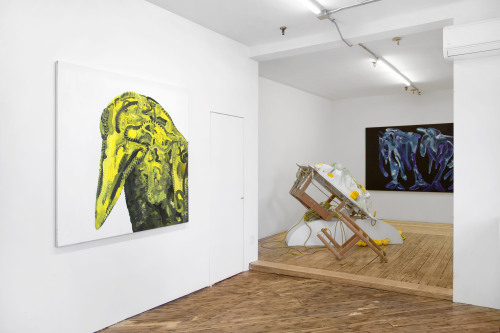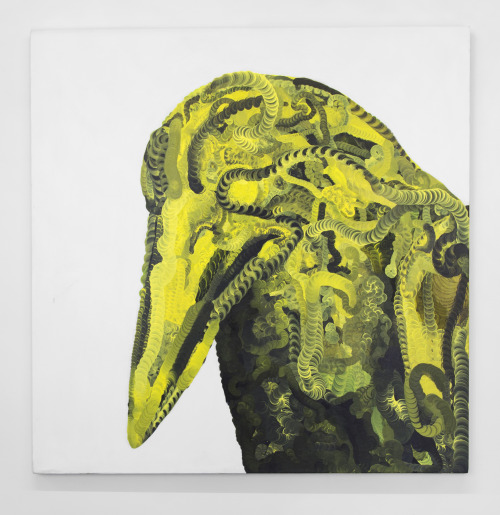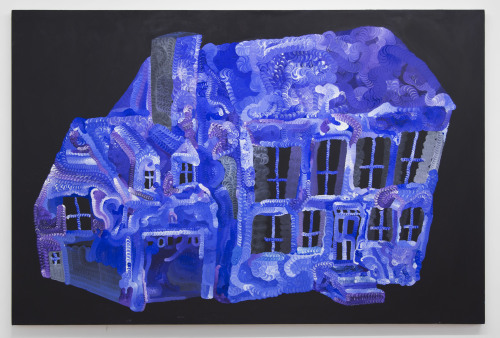
Installation view
Billy Grant’s art practice is expansive. He works in virtually every medium from painting, drawing and collage to sculpture, video, and performance. He collaborates constantly—his best known collaborative effort with the Virginia based art collective Dearraindrop which ran from 2001 to 2009. (Grant was one of three members of the group that included his sister Laura Grant and their friend Joe Grillo, and had originally been part of the collective Paperrad, in Boston.) In short, he is a force.
And that force was on full display earlier this year when he displayed a new body of paintings, in his two-person show with the sculptor and installation artist, Rich Porter at Safe Gallery. Grant brought his characteristic exuberance and obsessive attention to detail in a series of maximalist monochromes, which are created by attaching a paintbrush to the end of a drill. And we’ll experience it again January 19th, when his work is again on view, this time at Real Estate Gallery in a group show curated by Joe Bradley and Jeremy Willis.
This past week, I had a chance to sit down with Billy and discuss his childhood as an arsonist, how Dearraindrop evolved into a collective, his dedication to bizarre and unusual ways to make paintings, and why he’ll never be an abstractionist. I got right to it.
Irena Jurek: So, you used to be a pyromaniac, and you nearly burned your neighbor’s house down?
Billy Grant: Well, just the garage! I put a smoke bomb in the neighbor’s trash, over the fence, by jumping on a trampoline, and I guess a chlorine bottle caught on fire. Just as the trashcan was starting to smoke, Joe Grillo arrived with my sister, Laura, who he was dating at the time. He and Laura tried to put the fire out, but it did not work.
IJ: So that was the first time you met Joe?
BG: Yes, it was. Shortly after that, my mother came home, and I told her that I needed some lemonade, to put the fire out. She called the fire department, because I had gone through a long pyro phase, and I think that she wanted to teach me a lesson. The house did catch on fire as well, and the trashcan became a melted puddle of plastic. I was only ten at the time and that event changed my whole life.

Billy Grant
IJ: How did you decide to form Dearraindrop with Joe and Laura? Would you say it happened organically?
BG: We already made art together prior to Dearraindrop. It happened because we started having shows.
IJ: How would you say your work changes when you work in a collective as opposed to working on your own?
BG: I think that in the collective I have the freedom to be more confusing, and there’s a certain amount of feeding off of everyone else’s ideas. When I work alone, my ideas are based on ideas that I have always been interested in.
IJ: Your own ideas do seem very personal and based off of your own experiences. In your show at Safe Gallery, you painted your mother’s house, various memories, and animals.
BG: For that show I wanted to work with simple ideas. By reducing the colors and the composition, I allowed the material essence of the drill marks to take over the image. I was thinking about putting the material before the idea; similar to how you can look at a sand castle and think about the properties of sand. I wanted the paintings’ subject matter to be containers for this material, in which I filled the containers up with some kind of obsessive-compulsive gas.
IJ: That’s a really unusual way to think about making a painting. What’s curious about your new paintings is the process in which you make them by actually attaching a paintbrush to a drill.
BG: That process was the part that I highlighted the most in making these paintings. I also wasn’t making a solo show, and I took into consideration being that I was part of a two-person show. I created an extension or a simplified version of what I usually do.
IJ: Your paintings for this show do look more like objects, which in a way reiterates the physicality of Rich Porter’s sculptures.
BG: That was intentional. By making the paintings seem more like objects I wanted to creat a dialogue between Rich’s work and my work.
IJ: When did you first start making the drill paintings?
BG: I started painting with a drill about 5 years ago. I was experimenting with a lot of different ways to make a painting, and I was really interested in new tools for making work. It seemed to spring from my habit of trying to make the junk I collect somehow
useful. I often create reconfigurations of my junk, which I then usually just deconstruct or throw away.
IJ: These paintings are really animated, too. You achieved a sense of movement by combining the handmade with the machine.
BG: Yes, it seems like a recording of a drawing, because it’s a really simplified way of painting. I didn’t need to load the brush with a lot of different colors.
IJ: Most of them are monochromes or two-tone paintings, with a simple flat black or other one-color backdrop.

Billy Grant
BG: I was trying to amplify the effects that I achieved when I made these paintings in the past. Simplifying them made them more succinct.
IJ: There’s also a time-based aspect that’s created by combining the handmade with the machine. Looking at the swirling motions of the paintbrush, I’m very cognizant of the record of time embedded in these paintings.
BG: Definitely. It reads as the movements of the brush against the canvas, which in a way structures a sense of time.
IJ: There’s also something very playful and irreverent about your process.
BG: Yes, I like to have my character come through in things I make. I couldn’t just make them straight up abstract, time-based paintings. I prefer to work in expressive art forms that encapsulate aspects of my personality, and I approach most things with a sense of humor.


Comments on this entry are closed.